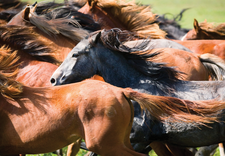Developing concurrent programs with Pony
Horse Power

© Lead Image © Aleksandr Frolov, 123RF
Pony, an object-oriented programming language with static typecasting, trots down well-mapped paths to deliver secure, high-performance code for concurrent applications.
The still young Pony [1] programming language uses the actor model [2] and capabilities [3] to make deadlocks and data races things of the past. In this article, I take Pony for a test ride with an example application that, once it has compiled successfully, logs the consumption of paint and reports the results in a single line.
Figure 1 revisits the problems of concurrent programming in C and C++. To improve performance, the hypothetical program outsources tasks to concurrent threads that access the shared memory area. Locks manage access to prevent different threads editing data simultaneously, falsifying each other's results in the process, and generating race conditions. Nothing good results when programming errors interact and create deadlocks.
[...]
Buy this article as PDF
(incl. VAT)
Buy Linux Magazine
Subscribe to our Linux Newsletters
Find Linux and Open Source Jobs
Subscribe to our ADMIN Newsletters
Support Our Work
Linux Magazine content is made possible with support from readers like you. Please consider contributing when you’ve found an article to be beneficial.

News
-
Parrot OS Switches to KDE Plasma Desktop
Yet another distro is making the move to the KDE Plasma desktop.
-
TUXEDO Announces Gemini 17
TUXEDO Computers has released the fourth generation of its Gemini laptop with plenty of updates.
-
Two New Distros Adopt Enlightenment
MX Moksha and AV Linux 25 join ranks with Bodhi Linux and embrace the Enlightenment desktop.
-
Solus Linux 4.8 Removes Python 2
Solus Linux 4.8 has been released with the latest Linux kernel, updated desktops, and a key removal.
-
Zorin OS 18 Hits over a Million Downloads
If you doubt Linux isn't gaining popularity, you only have to look at Zorin OS's download numbers.
-
TUXEDO Computers Scraps Snapdragon X1E-Based Laptop
Due to issues with a Snapdragon CPU, TUXEDO Computers has cancelled its plans to release a laptop based on this elite hardware.
-
Debian Unleashes Debian Libre Live
Debian Libre Live keeps your machine free of proprietary software.
-
Valve Announces Pending Release of Steam Machine
Shout it to the heavens: Steam Machine, powered by Linux, is set to arrive in 2026.
-
Happy Birthday, ADMIN Magazine!
ADMIN is celebrating its 15th anniversary with issue #90.
-
Another Linux Malware Discovered
Russian hackers use Hyper-V to hide malware within Linux virtual machines.


